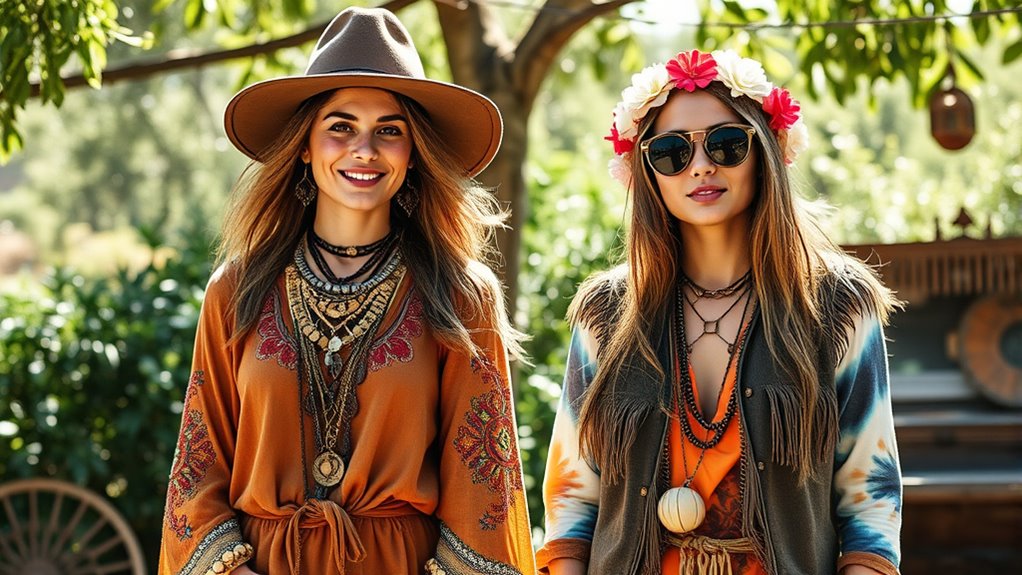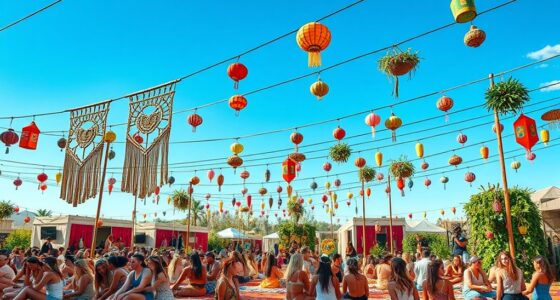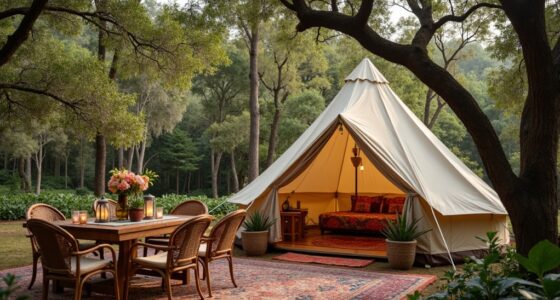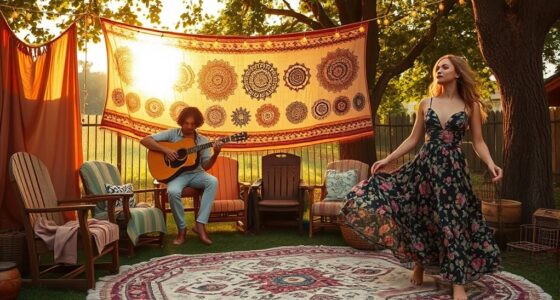Boho and hippie styles both celebrate individualism and eco-conscious living, but they have distinct roots. The hippie movement emerged in the 1960s, emphasizing peace, love, and activism, with relaxed, vintage-inspired fashion. Boho, inspired by early 20th-century artists and travelers, focuses on layered, eclectic, and handcrafted looks suited for urban environments. If you want to understand how their philosophies, fashion choices, and lifestyles differ further, there’s more to explore.
Key Takeaways
- Hippie style originated in the 1960s as a rebellious counterculture, while boho developed later with an emphasis on artistic, free-spirited living.
- Hippie fashion favors relaxed, vintage-inspired looks like tie-dye and fringe, whereas boho emphasizes layered accessories, earthy tones, and handcrafted pieces.
- Hippie lifestyles focus on activism, nature retreats, and spiritual exploration; boho tends to thrive in urban settings with a focus on creativity and individualism.
- Both prioritize sustainability and ethical fashion, but hippies often embrace simple, eco-conscious living, while boho integrates recycled and artisanal materials more trendily.
- Cultural symbols like peace signs and ethnic patterns are common in both, but hippies lean toward peace and love activism, while boho emphasizes eclectic, world-inspired aesthetics.
Origins and Historical Roots
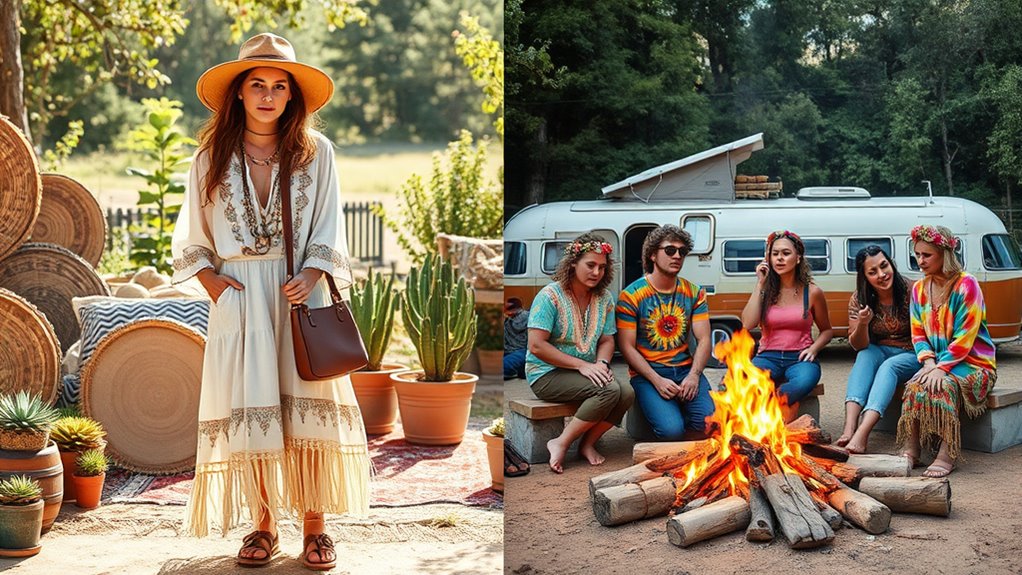
Although boho and hippie styles share some similarities, their origins and historical roots are distinct. The hippie movement emerged in the 1960s as a counterculture response to mainstream society, emphasizing peace, love, and rejecting materialism. Its fashion evolution included bell-bottoms, tie-dye, and fringe, reflecting a desire for freedom and individualism. Cultural diffusion played a key role, as hippies drew inspiration from Eastern philosophies, indigenous cultures, and folk traditions, blending these influences into their style. In contrast, the boho aesthetic developed later, influenced by bohemian artists and travelers in the early 20th century. It emphasizes free-spirited, eclectic fashion rooted in artistic expression and cultural mixing. Both styles celebrate individuality but differ in their historical contexts and cultural influences. Carrier oils and other aromatherapy techniques have been used historically to promote personal wellness and expression, reflecting the boho emphasis on holistic lifestyles. Additionally, the fashion trends of each movement highlight their unique cultural and historical backgrounds. The use of sustainable materials further distinguishes boho fashion from the more rebellious origins of hippie style.
Fashion and Aesthetic Choices
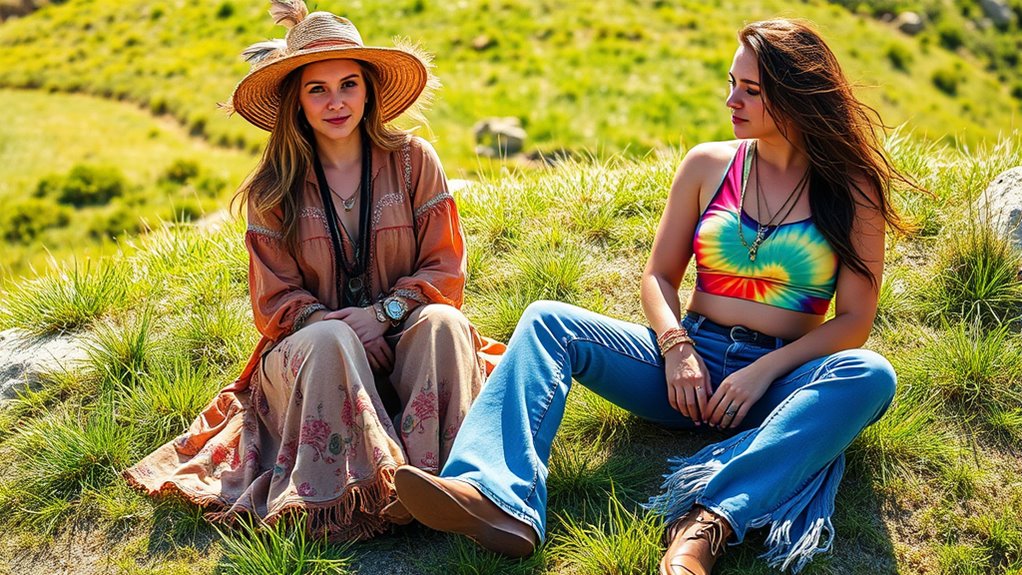
Boho and hippie styles express their unique identities through distinct fashion and aesthetic choices. You’ll notice that boho fashion emphasizes layered accessories and jewelry, often featuring earthy tones, beads, feathers, and eclectic pieces that create a free-spirited vibe. Hippie fashion, on the other hand, leans toward vintage-inspired, relaxed looks with tie-dye, bell-bottoms, and fringe details. When it comes to makeup and beauty, hippies prefer a natural, minimal approach, highlighting a fresh, effortless look with little to no makeup. Boho enthusiasts might incorporate more bohemian-inspired makeup, like earthy eyeshadows and subtle highlights, but still keep it understated. Additionally, the fashion and aesthetic choices of each style help convey their core philosophies of individuality and connection to nature. Understanding the drivetrain components involved in fashion choices can also reflect the importance of craftsmanship and sustainability in both styles. Overall, your style choices reflect your personality—whether you choose the layered, artistic boho aesthetic or the laid-back, vintage hippie vibe.
Core Values and Philosophies
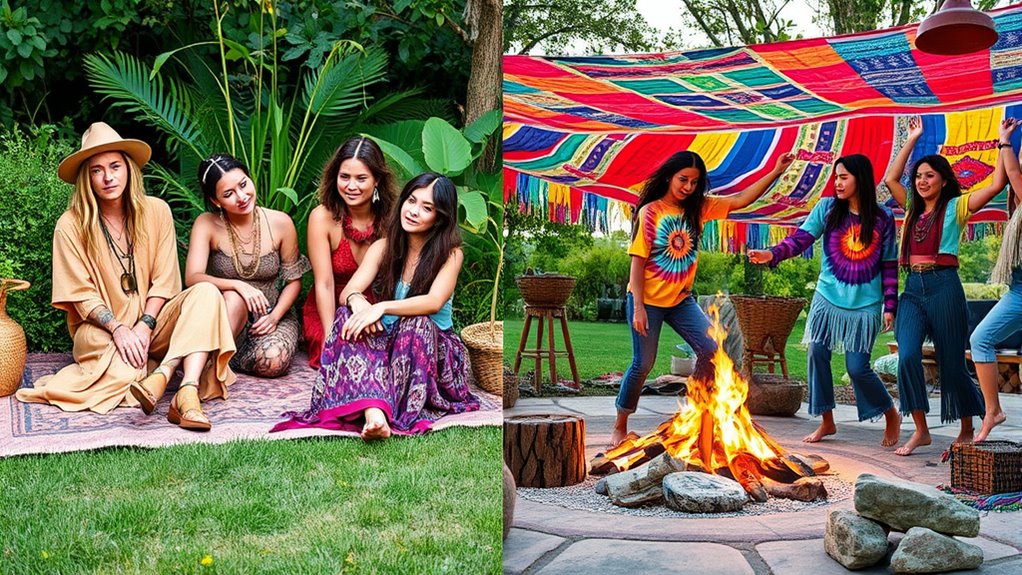
You might notice that both boho and hippie styles emphasize authentic spiritual beliefs and personal freedom. Each group values individual expression, shaping their choices around core philosophies. Understanding these differences helps you see how their values influence their lifestyles and attitudes. For example, some groups incorporate cultural traditions into their celebrations and daily practices, reflecting their diverse backgrounds and beliefs. Additionally, their symbolic artifacts often serve as expressions of deeper spiritual or philosophical principles.
Authentic Spiritual Beliefs
Authentic spiritual beliefs form the foundation of both boho and hippie lifestyles, guiding how you connect with yourself, others, and the universe. In both worlds, meditative practices serve as essential tools to achieve inner peace and clarity, fostering deeper self-awareness. Spiritual symbolism, such as crystals, feathers, or mandalas, holds significant meaning, representing universal energies or personal growth. Hippies often embrace a more laid-back approach rooted in Eastern philosophies, while boho adherents incorporate diverse spiritual symbols into their decor and fashion. Despite differences, both groups seek authenticity and harmony through their beliefs. These core values influence daily routines, rituals, and interactions, helping you cultivate a sense of purpose and spiritual connection that transcends materialism. Additionally, understanding the importance of sound recording techniques can enhance your spiritual practices by creating a calming environment through carefully crafted audio experiences. Recognizing the role of meditative practices can deepen your connection to these beliefs, fostering a more profound sense of inner peace and authenticity. Engaging in spiritual rituals can also strengthen your sense of community and personal growth, enriching your overall spiritual journey.
Individual Expression and Freedom
Both boho and hippie lifestyles prioritize individual expression and personal freedom as core principles. You’re encouraged to showcase your unique style through clothing, art, and attitudes that reflect your true self. Personal expression is central, allowing you to break free from societal norms and embrace your authenticity. The hippie movement emphasizes freedom in thought and lifestyle, advocating for peace, love, and community without restrictions. Conversely, boho style champions creativity and self-expression through a mix of vintage, ethnic, and eclectic influences. Both philosophies believe that true happiness comes from living authentically and freely, without conforming to external expectations. Your choices in fashion, beliefs, and daily life serve as a reflection of your inner values, reinforcing the importance of individual freedom in shaping your identity. Embracing self-expression strategies is essential for cultivating a lifestyle that aligns with these philosophies and supports your personal growth. Additionally, understanding the cultural influences behind each style can deepen your appreciation for their unique expressions of freedom and authenticity.
Approach to Sustainability and Ethical Living
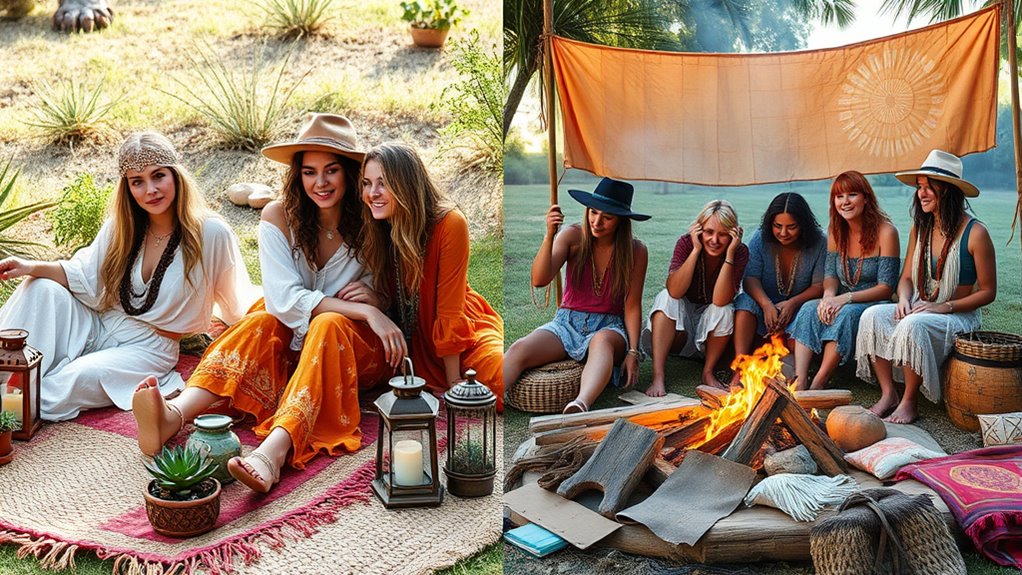
When it comes to sustainability, you’ll notice that both Boho and Hippie styles prioritize ethical fashion choices and eco-friendly practices. You might find that Boho fashion often incorporates sustainable materials and fair trade accessories, while Hippies embrace simple, eco-conscious lifestyles. Exploring how each approach integrates these values can reveal their unique perspectives on ethical living. Additionally, the use of eco-friendly materials and support for fair trade initiatives are common ways both groups demonstrate their commitment to sustainability. Many also incorporate recycled and upcycled elements into their wardrobe and lifestyle choices, further emphasizing their dedication to reducing environmental impact. Moreover, both styles often promote minimal waste and conscious consumption, reinforcing their shared commitment to environmental stewardship.
Ethical Fashion Choices
Have you ever considered how your fashion choices impact the planet and the people who make your clothes? When exploring ethical fashion, your focus might shift toward conscious consumption. For example:
- Choose boho jewelry made from sustainable or recycled materials, supporting artisans who prioritize ethical practices.
- Attend hippie gatherings that promote fair-trade clothing and accessories, emphasizing community-driven, eco-friendly styles.
- Research brands that prioritize transparency, ensuring their products are ethically sourced and produced.
- Incorporate wall organization systems into your space to create an environment that reflects your values of sustainability and mindful living.
- Understanding anime culture and storytelling can inspire more mindful and culturally aware fashion choices, fostering a deeper appreciation for diverse artistic expressions.
Eco-Friendly Lifestyle Practices
Adopting eco-friendly lifestyle practices means making conscious choices every day to reduce your environmental impact and support ethical living. You can start by improving your recycling habits, ensuring waste is sorted properly and materials are reused or repurposed. Embracing zero waste practices is another powerful step—aim to minimize single-use plastics, carry reusable bags, and choose products with eco-friendly packaging. These habits not only decrease landfill waste but also promote sustainability. You might also explore composting food scraps and donating items instead of discarding them. Every small action counts in creating a more sustainable lifestyle. Additionally, incorporating low light office plants can improve indoor air quality and add a natural touch to your environment. Incorporating sustainable materials into your home decor and daily routine can further reduce your ecological footprint. Using eco-friendly products can help decrease pollution and lessen your overall environmental impact. By integrating these practices into your routine, you help protect the planet and align with the values of both boho and hippie communities committed to ethical living.
Music and Cultural Influences

Music and cultural influences play a significant role in shaping both boho and hippie styles, reflecting their deep roots in artistic expression and countercultural ideals. You’ll notice that each style draws from distinct musical genres and cultural symbolism. For example: 1. The hippie movement often embraces psychedelic rock and folk, symbolizing peace and freedom. 2. Boho style incorporates world music like reggae and flamenco, emphasizing a free-spirited, eclectic vibe. 3. Both styles use cultural symbolism, such as peace signs or ethnic patterns, to express their beliefs and origins. Music isn’t just background; it’s a way to connect with the values of each movement. Whether you’re drawn to the rebellious energy of the 60s or the laid-back, global influences of boho, both styles celebrate artistic expression through sound and symbolism. Additionally, the integration of sound healing science techniques highlights how music and vibrations are used to promote well-being within these lifestyles. This connection to healing practices underscores the importance of music therapy in enhancing emotional and physical health through musical vibrations. Furthermore, modern adaptations of these styles often incorporate vibrational healing practices to deepen their holistic approach to wellness and self-expression.
Social Attitudes and Community Engagement
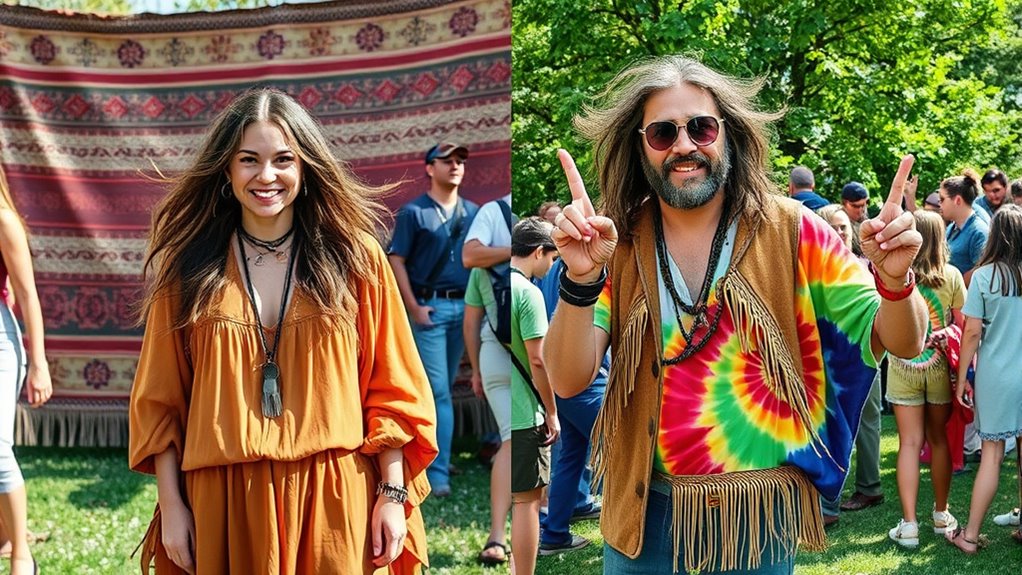
While both boho and hippie styles reflect distinct social attitudes, their approaches to community engagement set them apart. Hippies prioritize activist engagement, often participating in protests and social causes. They see community involvement as a way to challenge societal norms and promote peace. Boho enthusiasts, meanwhile, focus more on individual expression and less on organized activism. Their community involvement tends to be casual, centered around shared aesthetics and local gatherings. This table highlights the differences:
| Aspect | Hippie | Boho | Common Ground |
|---|---|---|---|
| Community involvement | Active, activism-focused | Casual, aesthetic-driven | Emphasize connection and expression |
| Activist engagement | Central to their identity | Less prominent | Value community and creativity |
| Approach to social change | Protest and advocacy | Personal style and gatherings | Both seek authentic community |
| Engagement style | Organized campaigns | Organic, informal | Focus on shared values |
Typical Environments and Settings
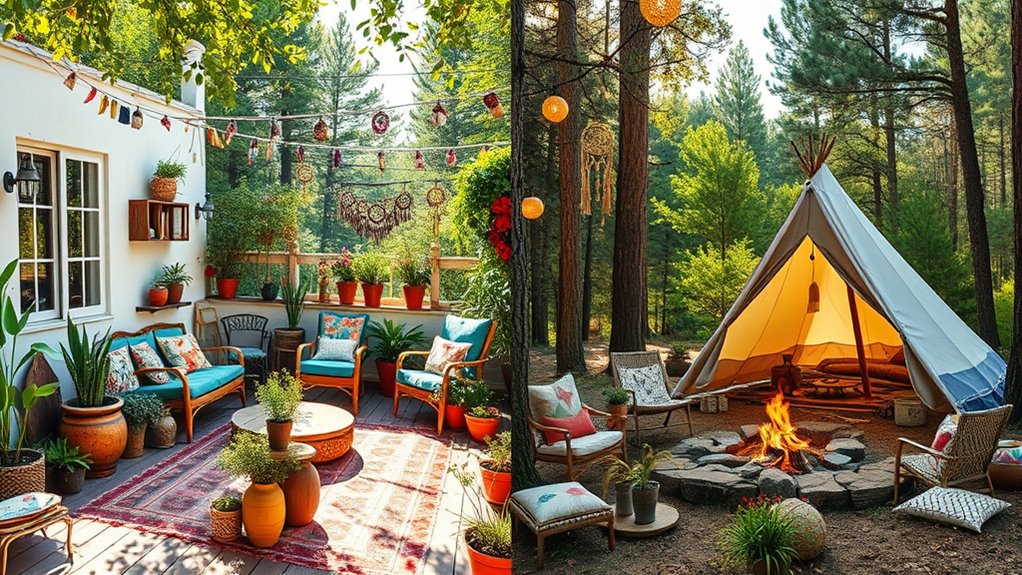
Boho and hippie styles both thrive in distinct environments that reflect their core values and social attitudes. You’ll find boho often in urban settings, where creativity and individualism shine through in trendy boutiques, art cafes, and eclectic neighborhoods. Hippies, on the other hand, prefer nature retreats, embracing open spaces, forests, and festivals that foster connection with the earth.
Consider these environments:
- Urban settings with vibrant street art and vintage shops, perfect for boho expression.
- Nature retreats featuring mountains, beaches, or rural communes, ideal for hippie lifestyles.
- Festivals and gatherings in both environments that promote community, spirituality, and freedom.
These settings shape how each style is experienced and expressed, emphasizing their unique lifestyles.
Frequently Asked Questions
How Do Boho and Hippie Communities Differ Geographically Today?
You’ll find that the geographic origins of boho and hippie communities still influence their dispersion today. Boho communities tend to be more urban, thriving in trendy neighborhoods and cities, while hippie communities often spread across rural areas or specific regions known for counterculture movements. This community dispersion reflects their roots—boho’s eclectic fashion in city life and hippie’s embrace of nature and freedom in more remote locations.
What Are Common Misconceptions About Boho and Hippie Lifestyles?
You might think boho and hippie lifestyles are just about fashion stereotypes, but they’re more complex. Many believe these styles mean free-spirited living without responsibilities, which isn’t true. People often overlook the intentionality behind their choices. Don’t assume that everyone embracing these styles rejects modern life; many blend tradition with modern values. Recognizing these lifestyle misconceptions helps you appreciate their true cultural significance beyond just clothing.
How Do Boho and Hippie Styles Evolve With Modern Trends?
Think of boho and hippie styles as chameleons blending into modern trends. You’ll see trendy adaptations like sustainable fabrics and minimalist influences, making these styles fresh and relevant. Cultural integration also plays a role, as designers incorporate diverse patterns and global motifs. You, as a wearer, can effortlessly mix vintage pieces with contemporary fashion, creating a look that’s uniquely yours while honoring the roots of these timeless styles.
Are There Any Significant Overlaps Between Boho and Hippie Fashion?
You’ll notice some shared aesthetic and fashion crossover between boho and hippie styles, like flowing fabrics, earthy tones, and vintage-inspired pieces. Both embrace a free-spirited vibe and love for unique accessories. While they have distinct roots, their visual similarities often blur lines, making it easy to see why fashion enthusiasts might mix and match elements from both, creating a boho-hippie fusion that’s effortlessly bohemian.
How Do These Lifestyles Influence Contemporary Interior Design?
Imagine your living space as a canvas, where boho decor and hippie interiors paint a story of freedom and creativity. You influence your home’s vibe by mixing vibrant textiles, vintage finds, and natural elements. This lifestyle encourages relaxed, eclectic spaces that reflect your individuality. By embracing these styles, you create an inviting sanctuary that celebrates spontaneity, turning your home into a personal expression of boho and hippie influences.
Conclusion
Imagine walking into a festival where both boho and hippie styles blend seamlessly—you instantly feel the vibrant energy and shared love for freedom. While their roots differ, both emphasize authenticity and expression. Understanding these differences helps you embrace your unique style and values. Like choosing between different melodies in a song, appreciating their nuances enriches your perspective. So, explore these worlds—your authentic self is waiting to be uncovered, just like discovering a new favorite tune.
